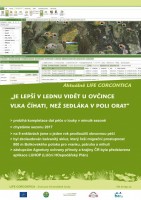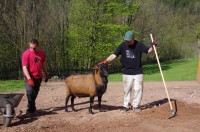The excursion to the Sklenářovice
The visit was short but beneficial. Our colleagues from the KRNAP Administration have become acquainted with the specifics of this natural monument - both with the history, the demise of the village and the economy as such, with the re-establishment of the management in the last decades and the care that we devote now.
Little about history
The settlement was probably built in the 15th century. The first mention of Glasendorf or Sklenářovice dates back to 1515. Originally, it was a glass village around the glass furnace.
Later, in the 16th century, gold was mined here and eventually gold. At that time, Sklenářovice was the biggest prosperity. The era, however, was short, the gold soon exhausted, and the miners left for better. Only the settlers living on the farm remained, and Sklenářovice became a peasant settlement.
At the beginning of the 20th century the village had its own self-government, a school, a mill and two inns. At that time 220 people lived in 42 houses.
After the Second World War, the inhabitants of Sklenářovice (who were predominantly of German nationality) were removed. After August 1946, only one family remained. Between 1959 and 1960 there was a great demolition (during the Demolition) and all the buildings, except for one, were destroyed. Today we can find only a few remains - such as the torso mill, which was built above the Zlatý potok stream.
The area of Sklenarovice was so cold and gradually grew. Of the original about 380 hectares of cultivated meadows today, only 110 ha remained, the rest ramped up, or spruce, and now forms a forest.
In the 1990s, time and considerable finance began to be invested in Sklenarovice, and the economy was gradually restored.
Present
Since the beginning of the year 1998, Sklenářovice has made tremendous progress, but the restoration work has not been far from here.
In 2009, the Sklenářovické údolí was declared a natural monument and since 2013 the LIFE CORCONTICA project is being cared for.
The only permanent settlement is Mr. Kadeřábek, who manages 3 ha of meadows. The rest of Sklenářovice restores, cuts and saves the only farmer (always tenant of KRNAP Land).
At the beginning of the restoration of the farm there were horses and cattle farm Hucul from Vítkovice, since 2009 they have taken their work Martin Maček and Ivana Čílová, who still manage to this day with about 250 sheep, some of the cow and the technique of senoseče.
The valley is filled with an extraordinary mosaic of meadows, pastures, watercourses, trees and forests.
Sklenářovice are very thermophilic due to the microclimatic conditions (in the sunny places the foothills of the plants are higher, on the shady ones the mountain below). There is a partial intersection and the creation of a mosaic as a bow from foothills and mountains.
We find here several different plant communities. Some of them are ranked among European habitats and fall under the LIFE CORCONTICA project.
The lowest is mesophilic oatmeal meadows - typical species that you could see here are the oat elevated, the fragrant tomato, the dew bell, the yarrow, the two-year hawthorn, the rattlesnake, the white daisy or the scorpion splinter.
The most common are mountain tribune meadows, whose typical representatives are forest cocoons, soft creepers, bells, rhodes, royal bells, and platanolist buttercups.
In the upper parts of the slopes, in the places where the nutrients are washed out, these are sub-mountain and mountain forage lawns, where we can find, for example, lanceolate lanceolate, nocturnal scallop, spurred spurge, arnica, five-spotted scorpion, mochunka, spurge and vitae.
There are locales that are grazing pastures, which are made up of poachers and poachers. These include creeping species such as creeping clover or squirrel clover, species of ground rosettes such as dandelion, autumn mackerel and larger squirrel. Other typical species for pastures are the grass of the dog, the scent, the scallop, the scallop, the annual grasshopper and others, for example, our famous hardcore solid.
The mosaic of the meadows is supplemented by wetland communities such as damp meadows and dwarf lakes.
The area is heavily wooded, the spruce trees go down in the mountain spruce, the beech trees (acidic to flowery) and the slopes and the fallow forests follow.
Some trees were planted here after the war, especially on the sites of the former fields, and today they form a typical spruce forest. Other trees rose from rains.
As valuable in the area, we see more extensive stands of draws and solitaires. Wood is too much. The woods are left by the forest, but the prunings and the groups of trees are pruned with care, so that the draws do not suffer much, while making room for grass species and pasture.
There are also degraded intensely managed meadows in Sklenarovice, which are known thanks to the large representation of dandelions or broadleaf grasses, such as the snakes and the meadow fox.
We also see degradation in excessive representation of St. John's wort, sorrels, and there is also a rosy snake root.
We do not find much degrading invasive plant species in Sklenářovice - in the lower part only a small amount of small wing. Sklenářovice jak one of the few enclaves is not hit by alpine or lupine. Expansion species are already a little more here. In places that are abundantly supplied with nutrients, we can find a common nettles or a dappled sorrel. A major problem and paradox is the spread of the white Lobell sore, especially in humid places. For the Czech Republic, it belongs to the red list of particularly protected and endangered plant species among C4a - species requiring attention, but in the Giant Mountains it is a type of expansive, spreading at the expense of other species. Ispreads in the bushes and along the untreated meadows.
There are 300 plant species in the Sklenářovice Valley, of which 20 are especially protected and endangered.
During the excursion, we also showed the importance of leaving uncut belts. Keeping belts, preferably in the most florid places, is important for invertebrate animals. These areas serve insects as a source of food, shelter, for breeding, but also overwintering.
An example of invertebrate monitoring was trampling with insect netting. On the areas that have been sown, we have not seen many species, nor did they catch them, because there was more than enough in the unspoiled vegetation.
The news in the valley is a fenced enclosure - a grazing area that should facilitate the care of a whole 110 ha. so-called Anglo-Saxon-New Zealand. It consists of split stakes made of acacia wood, three towed conductors, reinforced horns and several appropriately located gates. A total of 19 km of fencing was built at a height of one meter, using 57 km of wire, 170 horns and 50 gates were created.
Appropriately positioned so that, when the grazing enclosure is not used, it could be used as a wildlife corridor. So the valley is unsealed and migratively permeable. Reserves are divided into several different districts - the largest ones are still divided into smaller parts with the help of a classical electric fencing - networks.
The durability of such type of enclosure is about 40 years.
The wel-known picture was a demonstration of special interventions, how the cutouts and struc- tures made from the framework contracts, and the work of our boys from the working group. This time, we have shown that not every rib is simple and not even the finest pepper with the stones in the ground. The winch once had the chance to watch, this time the show was better. The power and assistance of the winch proved to be full when pulling the whole fall tree. The novelty introduced to us is a cutter for cutting stump cutouts. Our cutter is smaller, it manages only stumps up to about 10 cm in diameter, but it is also an invaluable helper where the cuttings will cut meadows.
Finally, we can say that the work in the valley is long, heavy, and it will take many years for us to give the Gladiator the face he deserves. A face full of colorful meadows, vegetation mosaics, modified draws and walls, species diversity and a successful territory that will give joy to nature conservation, but also as a natural and, most importantly, cultural monument with a memory of ancestors' life.







